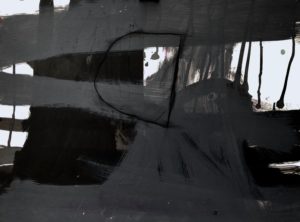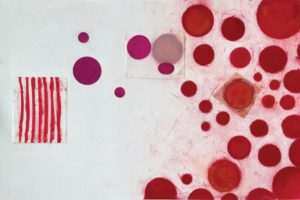During the pandemic lockdown, Betty Carroll Fuller spent a lot of time alone in her Falmouth home and studio. It coincided with her recovery from a rare form of cancer, diagnosed in January 2020.
“I started listening to musicians I loved,” she says. In a way, she muses, it was like inviting a rotating cast of jazz musicians into her studio for company. They seem to have stuck around — their presence is felt in her current exhibition, “Just One More Bite,” at Farm Projects in Wellfleet.

In the show, she titles a series of small works on paper after the musicians. In Studio Visitor (Bill Evans) and Studio Visitor (Coltrane) she works with the image of the grid in velvety black charcoal and India ink — materials for which she has an abiding love. The grid here is not a normal one, fixed and formalized. Instead, the structure of the grid wobbles in both pieces. The works transform the grid from a symbol of order into a symbol of something more unpredictable: the messy process of making art. Fuller’s work feels like a submission to that reality.
Some of her works, however, such as her drawings of taped-off horizontal lines, are all about control and precision. And in others, Fuller indulges in loose painterly gestures. The exhibition, taken as a whole, is all about this fluctuation. This seesawing between precision and irregularity mimics the experience of listening to jazz — improvisational flourishes layered atop structured rhythms.
“The grid always reminds me of the stand-up bass in a band,” says Fuller. “It’s the foundation, and sometimes it’s a solo.”
In Fuller’s Late Summer, Afternoon, the grid is the main act. In this ink drawing, her intersecting lines reference a childhood memory of reading on her lattice-enclosed porch in coastal Maryland. “I used to hide out there and read,” she says, recalling the “beautiful cast shadows on the floor.” The artwork’s interplay between black and white references the late afternoon light while the lines, like shadows, quiver with imprecision.

Fuller’s reference to concrete visual experiences may come as a surprise to a viewer of the show, given the work’s roots in nonreferential, minimalist abstraction. “My work is abstract, but it all has a narrative edge in my mind,” says Fuller.
Her cancer treatment and her upcoming 75th birthday have made her think a lot about the past. In another grid-based drawing, One Summer Night on the Glen Echo Roller Coaster, Fuller remembers sneaking out at night for a summer adventure. The lines in this drawing reel with whole-body gestures, recalling the wild energy of a youthful escapade.
She continues building on this frenetic energy in her drawing A Darkness So Pure (Sylvia Plath). Here, Fuller is at her most improvisational. The grid vaguely appears through dominant horizontal and vertical gestures, but it’s broken up with drips of paint, slashing brushstrokes, and a crudely drawn shape on the surface of the image. The piece echoes the dark intensity of Sylvia Plath’s poems.

There’s a subtlety in the range of blacks in the work. Throughout the show, Fuller expands the viewer’s understanding of black from a uniform value to something rich with variety. “I find dark comforting,” says Fuller. “The sky is so beautiful on winter nights.” If one looks closely enough, the darks in Fuller’s drawings reveal complex nuances not unlike that of a nocturne.
Impressions of the natural world also inform Fuller’s drawings of horizontal black stripes on white grounds. The three large drawings reference three types of tides: spring tide, neap tide, and sparrow tide. In these works, the tempo is slower, the effect quieter and more peaceful. “There’s something soothing about stripes,” says Fuller, drawing parallels between the landscape of the coast and her horizontal abstractions.
Even with all these sources of inspiration, Fuller returns to that ultimate fountain: jazz. Referencing Bill Evans’s piano arrangement “Peace, Piece,” Fuller speaks of “the space between the notes.”
“I think of that when I do the drawings,” she says. It’s apparent in these works, where the negative space seems as intentional and pregnant with feeling as the heavy black bands.
Aside from the black-and-white work, the show features two red drawings based on love poems by Nikki Giovanni. In these pieces, she works with circles, which exist in compositional tension with larger geometric shapes. Balance is a central concern here. “We all try to balance things in life,” Fuller says, easily drawing connections between abstraction and lived experience.

The show is an impressive rebound — symphonic in range — and astonishingly created in the throes of recovery from illness. As for the show’s title, recently Fuller was reading a book and came across the phrase “one more bite.” It resonated with her. “After Covid and cancer I thought I want just one more bite of what I do,” she said. When Susie Nielsen of Farm Projects asked her to do the show, she thought, “This will be my one more bite.”
Imprecise Precision
The event: “Just One More Bite,” an exhibition of works by Betty Carroll Fuller
The time: Through Aug. 15; artist talk on Thursday, Aug. 11, 5 p.m.
The place: Farm Projects (355 Main St., Wellfleet)
The cost: Free



